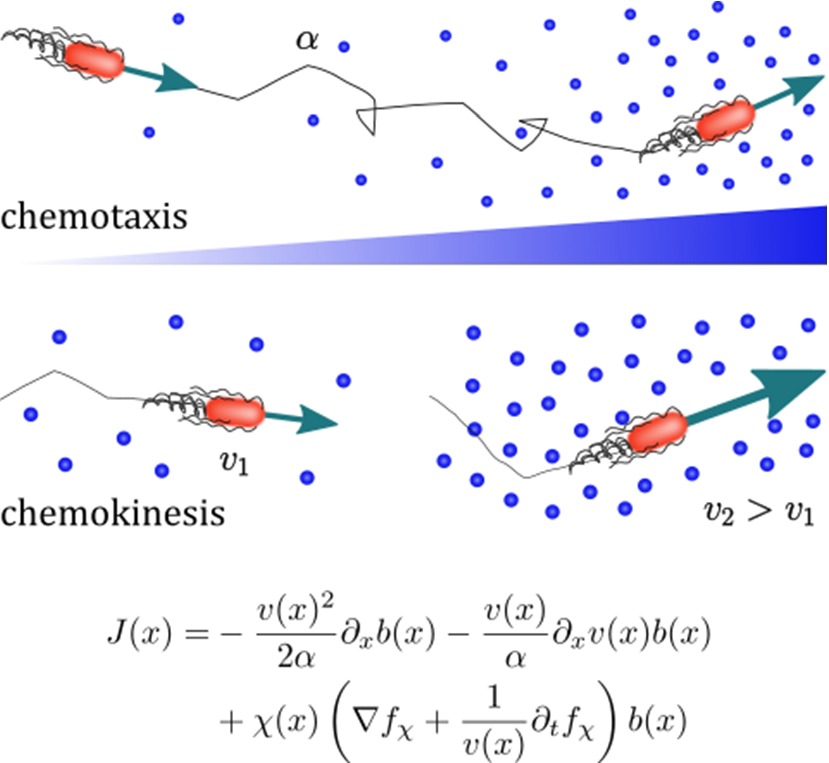https://doi.org/10.1140/epje/s10189-021-00009-w
Regular Article - Living Systems
Migration and accumulation of bacteria with chemotaxis and chemokinesis
1
Cavendish Laboratory, University of Cambridge, CB3 0HE, Cambridge, UK
2
Department of Civil, Environmental and Geomatic Engineering, Institute of Environmental Engineering, ETH Zürich, 8093, Zürich, Switzerland
3
Present address: School of Mathematics, Statistics and Physics, Newcastle University, NE1 7RU, Newcastle upon Tyne, UK
a
theresa.jakuszeit@curie.fr
d
o.croze@physics.org
Received:
17
September
2020
Accepted:
5
January
2021
Published online:
15
March
2021
Bacteria can chemotactically migrate up attractant gradients by controlling run-and-tumble motility patterns. In addition to this well-known chemotactic behaviour, several soil and marine bacterial species perform chemokinesis; they adjust their swimming speed according to the local concentration of chemoeffector, with higher speed at higher concentration. A field of attractant then induces a spatially varying swimming speed, which results in a drift towards lower attractant concentrations—contrary to the drift created by chemotaxis. Here, to explore the biological benefits of chemokinesis and investigate its impact on the chemotactic response, we extend a Keller–Segel-type model to include chemokinesis. We apply the model to predict the dynamics of bacterial populations capable of chemokinesis and chemotaxis in chemoeffector fields inspired by microfluidic and agar plate migration assays. We find that chemokinesis combined with chemotaxis not only may enhance the population response with respect to pure chemotaxis, but also modifies it qualitatively. We conclude presenting predictions for bacteria around dynamic finite-size nutrient sources, simulating, e.g. a marine particle or a root. We show that chemokinesis can reduce the measuring bias that is created by a decaying attractant gradient.
Supplementary Information The online version supplementary material available at https://doi.org/10.1140/epje/s10189-021-00009-w.
© The Author(s) 2021
 Open Access This article is licensed under a Creative Commons Attribution 4.0 International License, which permits use, sharing, adaptation, distribution and reproduction in any medium or format, as long as you give appropriate credit to the original author(s) and the source, provide a link to the Creative Commons licence, and indicate if changes were made. The images or other third party material in this article are included in the article’s Creative Commons licence, unless indicated otherwise in a credit line to the material. If material is not included in the article’s Creative Commons licence and your intended use is not permitted by statutory regulation or exceeds the permitted use, you will need to obtain permission directly from the copyright holder. To view a copy of this licence, visit http://creativecommons.org/licenses/by/4.0/.
Open Access This article is licensed under a Creative Commons Attribution 4.0 International License, which permits use, sharing, adaptation, distribution and reproduction in any medium or format, as long as you give appropriate credit to the original author(s) and the source, provide a link to the Creative Commons licence, and indicate if changes were made. The images or other third party material in this article are included in the article’s Creative Commons licence, unless indicated otherwise in a credit line to the material. If material is not included in the article’s Creative Commons licence and your intended use is not permitted by statutory regulation or exceeds the permitted use, you will need to obtain permission directly from the copyright holder. To view a copy of this licence, visit http://creativecommons.org/licenses/by/4.0/.





